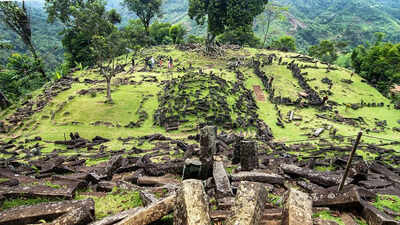A controversial claim suggesting that a pyramid in Indonesia dates back 25,000 years has ignited worldwide curiosity, directly challenging conventional timelines of human civilisation. While the theory has since been retracted, it has sparked vigorous debate among archaeologists, historians, and enthusiasts about the interpretation of ancient structures and the methods used to date them. The discussion raises deeper questions about humanity’s early technological capabilities, the accuracy of established historical narratives, and the role of scientific scrutiny in evaluating extraordinary claims. Even retracted, the idea fuels public imagination, highlighting how single discoveries or alleged discoveries can provoke reassessment of what we know about prehistoric societies and the possible sophistication of early human civilisations.
Gunung Padang: Indonesia’s 25,000-year-old pyramid predating known Megaliths
Gunung Padang, meaning “Mountain of Enlightenment,” is located in the misty highlands of West Java, Indonesia, nearly 3,000 feet above sea level. Its terraces, covered in moss and stone formations, have been revered for generations as a sacred site, hosting rituals and community events. The site’s elevated position offers panoramic views of the surrounding volcanic landscape, adding to its mystique. For centuries, locals acknowledged it as a place of spiritual significance, but it was largely unknown to the wider world until scientific studies brought it into global focus. In late 2023, a study published in the journal Archaeological Prospection suggested that Gunung Padang could be the world’s oldest pyramid. Led by geologist Danny Hilman Natawidjaja of Indonesia’s BRIN research agency, the team used ground-penetrating radar, seismic tomography, and radiocarbon dating of soil samples to examine layers beneath the visible terraces.The researchers claimed that the deepest layer, referred to as Unit 3, dated between 25,000 and 14,000 BCE, placing it in the Paleolithic era. Upper terraces were dated between 6,000 BCE and 2,000 BCE, aligning with known megalithic traditions in Southeast Asia. The study reported evidence of stacked stones, cavities resembling chambers, and mortar-like materials between rocks interpreted as signs of human construction. If correct, these findings would predate Göbekli Tepe in Turkey, currently recognised as the oldest monumental site at 11,000 years.
Experts challenge Gunung Padang’s 25,000-year-old Pyramid claim
The claim was met with intense scepticism from archaeologists and geologists. Experts highlighted several key issues: the absence of tools, charcoal, or human remains; the unreliability of soil radiocarbon dating to determine construction; and the possibility that natural geological processes could create formations resembling terraces or chambers.Flint Dibble, an archaeologist at Cardiff University, warned that the findings risked confusing natural volcanic formations with intentional human architecture. Critics argued that extraordinary claims demand extraordinary evidence, and the data presented did not meet this standard. In early 2024, Archaeological Prospection officially retracted the study. The journal stated that the conclusions were “not adequately supported by the evidence provided” and that the geophysical interpretations failed to meet scientific standards.The retraction reignited debates about the boundaries of archaeology, the openness of the scientific community to unconventional ideas, and how researchers distinguish between natural phenomena and human-made structures.
Gunung Padang: Controversy, alternative history, and its ancient heritage
Despite the retraction, Natawidjaja defended his research, calling the criticism “censorship” and accusing mainstream science of resisting new models of human history. His claims attracted interest from alternative history proponents, including Graham Hancock, author of Ancient Apocalypse, who acted as a proofreader for the study.Hancock’s theories propose a lost Ice Age civilisation destroyed by a global catastrophe, ideas largely rejected by mainstream archaeologists. However, his involvement amplified public fascination with Gunung Padang, positioning it as a focal point for theories about advanced prehistoric cultures and forgotten epochs.Also Read | Top 10 most polluted cities in the world: Delhi out of top 10 as toxic smog covers north India Go to Source



